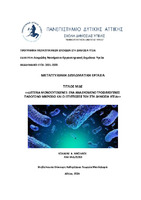| dc.contributor.advisor | MANDILARA, GEORGIA | |
| dc.contributor.author | Κολαζάς, Νικόλαος | |
| dc.date.accessioned | 2024-10-09T08:41:53Z | |
| dc.date.available | 2024-10-09T08:41:53Z | |
| dc.date.issued | 2024-09-27 | |
| dc.identifier.uri | https://polynoe.lib.uniwa.gr/xmlui/handle/11400/7638 | |
| dc.identifier.uri | http://dx.doi.org/10.26265/polynoe-7470 | |
| dc.description.abstract | Το γένος βακτηρίων Listeria αποτελείται από gram θετικούς και προαιρετικά αναερόβιους
βακίλους οι οποίοι δρουν ως ενδοκυτταρικά παθογόνα. Έχουν προσδιοριστεί, έως το 2022,
21 είδη. Το κύριο παθογόνο είδος που προκαλεί νόσο στον άνθρωπο είναι η Listeria
monocytogenes η οποία προκαλεί τη ζωονόσο Λιστερίωση. Η L.monocytogenes είναι
ιδιαίτερα διαδεδομένη στο περιβάλλον αφού αποικίζει τόσο χώμα και φυτά, όσο και το
γαστρεντερικό σωλήνα των θηλαστικών. Είναι επομένως δυνατή η επιμόλυνση τροφίμων
που προορίζονται για ανθρώπινη κατανάλωση από το βακτήριο, με συνέπεια και τη
μόλυνση του ανθρώπου από κατανάλωση των μολυσμένων τροφίμων. Πράγματι
μολυσμένα τρόφιμα όπως γάλα, γαλακτοκομικά προϊόντα, κρέας και κρεατοσκευάσματα
έχουν συσχετιστεί στο παρελθόν με επιδημίες λιστερίωσης. Παρά την σχετικά μικρή
συχνότητα εμφάνισης της νόσου, η βαρύτητα της κλινικής εικόνας, ιδιαίτερα σε εγκύους,
ανοσοκατεσταλμένους ενήλικες, ηλικιωμένους και παιδιά, την καθιστούν ένα σημαντικό
θέμα δημόσιας και ενιαίας υγείας. Η αύξηση των κρουσμάτων λιστερίωσης σε Ευρώπη και
Ελλάδα τα τελευταία χρόνια σε συνδυασμό με την αυξημένη νοσηρότητα και θνητότητα
της νόσου προκαλούν ανησυχία ως προς τις επιπτώσεις της νόσου και τις προεκτάσεις που
δύναται να υπάρχουν στη δημόσια υγεία. Σκοπός της παρούσας διπλωματικής εργασίας
είναι να παρουσιαστούν τα νεότερα δεδομένα συνολικά σχετικά με το παθογόνο μικρόβιο
L.monocytogenes, την επιδημιολογία του και τα επιδημιολογικά δεδομένα από Ευρώπη
και Ελλάδα. Η παρούσα διπλωματική εργασία στοχεύει επίσης στην κατανόηση της
παθογένειας του μικροβίου και της λοιμογόνου δράσης του. Γίνεται εκτενής αναφορά στις
μεθόδους ανίχνευσης της λιστέριας σε κλινικό δείγμα όσο και σε τρόφιμα, καθώς και στις
μεθόδους τυποποίησης και οροτυποποίησης του παθογόνου. Παρέχεται επίσης μια
επισκόπηση των θεραπευτικών πρωτοκόλλων και σχημάτων, σε συνδυασμό με την
τρέχουσα κατάσταση αντιμικροβιακής αντοχής του παθογόνου μικροβίου. Ο απώτερος
σκοπός της εργασίας είναι η ανάλυση των συστημάτων επιτήρησης και των μεθόδων
πρόληψης της νόσου αναδεικνύοντας ταυτόχρονα τη λιστερίωση ως μείζον θέμα ενιαίας
υγείας. | el |
| dc.format.extent | 78 | el |
| dc.language.iso | el | el |
| dc.publisher | Πανεπιστήμιο Δυτικής Αττικής | el |
| dc.rights | Αναφορά Δημιουργού - Μη Εμπορική Χρήση - Παρόμοια Διανομή 4.0 Διεθνές | * |
| dc.rights.uri | https://creativecommons.org/licenses/by-nc-sa/4.0/deed.el | * |
| dc.subject | Listeria monocytogenes | el |
| dc.subject | Λιστερίωση | el |
| dc.subject | Τροφιμογενείς λοιμώξεις | el |
| dc.subject | Δημόσια Υγεία | el |
| dc.subject | Ενιαία Υγεία | el |
| dc.subject | Listeria | el |
| dc.subject | Bacteria | el |
| dc.subject | Public health | el |
| dc.subject | Foodborne infections | el |
| dc.subject | Zoonosis listeriosis | el |
| dc.title | Listeria monocytogenes: ένα αναδυόμενο τροφιμογενές παθογόνο και οι επιπτώσεις του στη δημόσια υγεία | el |
| dc.title.alternative | Listeria monocytogenes: an emerging foodborne pathogen and its impact on public health | el |
| dc.type | Μεταπτυχιακή διπλωματική εργασία | el |
| dc.contributor.committee | Papadogiannakis, Emmanouil | |
| dc.contributor.committee | Κονταρίνη, Μαριέττα | |
| dc.contributor.faculty | Σχολή Δημόσιας Υγείας | el |
| dc.contributor.department | Τμήμα Πολιτικών Δημόσιας Υγείας | el |
| dc.contributor.master | Δημόσιας Υγείας | el |
| dc.description.abstracttranslated | The bacterial genus Listeria consists of gram positive and facultative anaerobic bacilli acting
as intracellular pathogens. 21 species have been identified up to 2022. The major pathogen
species acting as a human pathogen is Listeria monocytogenes that causes the zoonosis
listeriosis. L.monocytogenes is widely spread in the environment since it can be found not
only in plants and soil, but it also colonizes the gastrointestinal mucosa of mammals.
Contamination of food destined for human consumption from the bacterium is therefore
possible, resulting in human foodborne infection. There have been correlations in the past
between epidemics of listeriosis and consumption of contaminated products, such as milk,
dairy products, meat and meat products. Despite the low frequency of disease occurring,
the severity of clinical signs, especially in pregnant women, immunocompromised adults,
elder people and children, render it an important issue of both public health one health.
The increase in cases of listeriosis in Europe and Greece the last few years, in combination
with the high morbidity and case fatality ratios of the disease raise concern about the
impact of the disease and its extensions in public health. The present systematic review
aims to present the latest data about L.monocytogenes, its epidemiology and the latest
epidemiological data from Europe and Greece. It also aims to understand the mechanisms
of pathogenesis of the infection. There are detailed mentions of the bacterial isolation
methods in both clinical samples and food products, as well as serotyping and identification
methods. There is also a summary of therapeutic protocols in correlation with the latest
data on antimicrobial resistance. The ultimate goal of this review is to analyze the
surveillance systems and preventive measures for the disease, while pointing out Listeriosis
as a major public health issue. | el |


